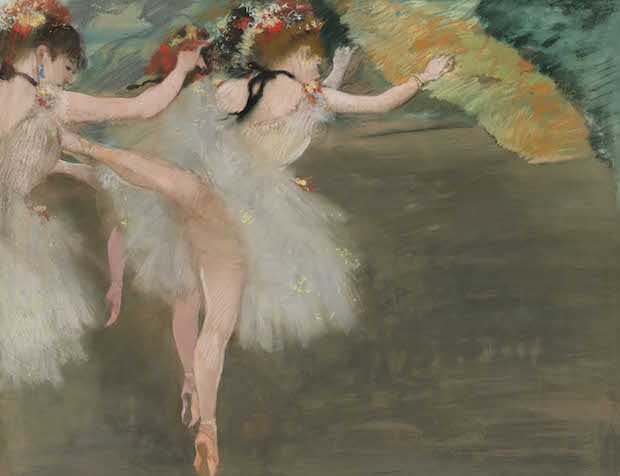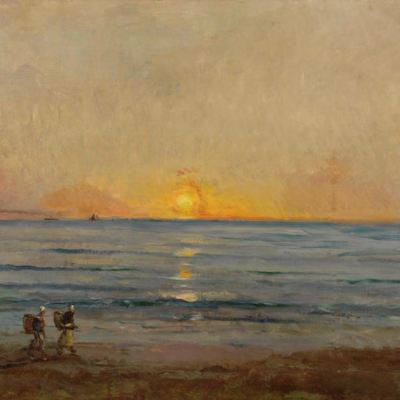Pastels, a mixture of powdered pigments with a filler, such as plaster, and a binder, usually gum arabic, first became a significant artistic medium in the 18th century. Used by Leonardo da Vinci and other Renaissance artists to add highlights to chalk drawings or as a preparatory medium for an oil painting, in the early 18th century the Venetian portraitist Rosalba Carriera found a ready market among Grand Tourists for her lustrous, vividly coloured large-scale portraits, with their miniaturist’s attention to detail. Carriera stayed in Paris between 1720 and 1721, igniting a craze for pastels that spread through France to Britain. Maurice-Quentin de La Tour and Jean-Baptiste Perronneau were renowned pastel portraitists, while Jean-Étienne Liotard, from Geneva, travelled from one European court to another, dazzling people with the gorgeous immediacy of his portraits. Chardin notably turned to pastels in later life.
The proponents of neoclassicism had little time for the medium, so it was in emulation of these earlier masters that Delacroix, Millet and Manet began to experiment with pastels in the middle of the 19th century. It was, however, Manet’s friend, Edgar Degas, who made the medium his own, increasingly adopting pastels from 1875 onwards and making some of his most important works with them. He submitted a suite of nudes, all rendered in pastel, to the final Impressionist exhibition in 1886, showing his mastery of this vital, sensuous medium with its glowing colours. While Mary Cassatt was perhaps the only other Impressionist to produce her major work in pastel, many others experimented with it, including Renoir, Pissarro, Sisley, Morisot, and Monet, revelling in the medium’s capacity to render the freshness of nature and intimate informality of domestic life.
Among Post-Impressionists, including Vuillard and Picasso, it is the symbolist Odilon Redon who most excelled in the medium, turning to pastel after 1895 once he had abandoned lithography and his famous noirs, finding in its brilliant colours a potent means of communicating his intense visions. And it is worth remembering that Munch also used pastel to create, among other images, the version of The Scream (1895) acquired by Leon Black at Sotheby’s New York in 2012 for just short of $120m.
Carmen (c. 1928), Georges Rouault. Christie’s Images Ltd. (£10,000–£15,000)

In art-historical terms, the medium has slipped between categories. As early as 1684, the French critic Roger de Piles described pastel as a type of painting, while in 1690, André Félibien defined it as a mode of drawing that had the same effect as painting, but which could not be classed as painting. The same is true in the market place. According to Keith Gill, head of Impressionist and modern art at Christie’s, ‘pastels will be valued most highly’ of all works on paper by Impressionist and Post-Impressionist artists, but rarely as highly as their paintings.
However, they don’t come up for sale very often. The medium is friable, the surface easily damaged, and the paper can be ruined by acidic mounts. The rarity of pastels in good condition, married to ‘the unbelievable mastery’ required to achieve something strong in the medium, can result in very good prices, Gill says. He cites the $5.02m paid in 2007 for Renoir’s charmingly domestic La Lecture of around 1889, or the $1.9m paid for Pissarro’s Chaumières à Auvers, près de Pontoise (1879) in 2000. More recently, substantial prices were achieved for pastels by Georges Rouault at Christie’s New York last November – including $93,750 for La famille du clown (1930). At the time of writing, more Rouault pastels have been consigned to Christie’s London’s upcoming sale of works from the personal collection of Barbara Lambrecht on 28 February and 1 March.
Undoubtedly Degas is the big hitter, with all three of his top prices being for works in gouache and pastel – leading with the $37m paid at Sotheby’s New York in 2008 for his Danseuse au repos of around 1879. ‘What you want with Degas is a ballerina or dancer,’ says Gill. ‘They are iconic. This was where he was at his very best. For a collector, these are the most sought after.’ Alfred Taubman, Sotheby’s chairman for many years, was one such collector. In the sale of masterworks from his collection at Sotheby’s New York in 2015, Danseuses en blanc (c. 1878) sold for just over $17m, and Danseuses of 1895–1900 fetched just over $6m. The previous May, Trois danseuses, which Degas produced around 1900, achieved $11.9m at Christie’s New York.
Danseuse au repos (c. 1879), Edgar Degas. Courtesy Sotheby’s ($37.04m)

Georgina Gold, senior director in the Impressionist and modern art department at Sotheby’s, suggests that collectors ‘are looking for colour – you can get real fireworks with pastels’ – and adds that the medium ‘is very unforgiving, with a wonderful sense of immediacy and spontaneity’. She cites the floral paintings of Redon, whose Vase au guerrier japonais, c. 1905, established an auction record for the artist (£2,036,500) in London in 2008. The number of dedicated collectors of works on paper is declining, but outstanding pastels can appeal to the increasing numbers of masterpiece collectors, both in Europe and North America, and in emerging markets in Russia, South America, and Asia. Gold says: ‘Collectors today worldwide have so much more knowledge about archival mounts, how to frame, how to conserve in different climates, and so on, than in the past, which gives them confidence to buy works on paper.’
Vase au guerrier japonais (c. 1905), Odilon Redon. Courtesy Sotheby’s (£2.04m)

Stephen Ongpin, a London-based dealer in drawings and works on paper, mounted an exhibition of 33 pastels in 2014, with works by Boudin, Degas, Sisley, Monet and Munch, among others. ‘A lot of these artists are wonderful draughtsmen,’ he says. Two of the delicate, moody coastal landscapes by Degas, dated to 1869, are still available, for between £100,000 and £200,000. Ongpin points out that Monet turned to pastels at certain crucial moments – in the 1860s, the 1880s and in London in 1901, when his materials and paintings of Waterloo Bridge were held up in customs. He turned to pastels to pass the time. Susan Morris, senior researcher at London dealership Richard Green, tells me that Monet kept hold of many of his early experimental pastels from the 1860s – ‘he is recording directly what he is seeing’ – as they had value for him. Currently, the dealership has a pastel sketch, Paysage, environs du Havre, from 1868, which Monet donated in 1916 to a lottery to aid families of French prisoners of war (price on request). It also has an atmospheric pastel, Au théâtre (c. 1900), by Degas’ friend, Federico Zandomeneghi (price on request). ‘For us, condition is always paramount,’ says Morris.
This month sees Salon du Dessin (22–27 March) open its doors in Paris, and among the highlights is Carlos Schwabe’s pastel of his daughter aged seven (1908). Offered by the Paris dealer Mathieu Néouze, who specialises in symbolist painters, this tender portrait is priced around €20,000. Meanwhile Agnès Aittouarès of Galerie AB, a specialist in works on paper, presents a bright abstract work by Sonia Delaunay, Etude pour marché Portugais (1915). Aittouarès comments that Delaunay used pastel at this time to explore ‘the rapport between colour and form’, and only sold this study in 1972 to a Portuguese collector. ‘Pastel is a medium that offers much to collectors,’ she says. ‘It is very appealing.’
From the March 2017 issue of Apollo. Preview and subscribe here.



